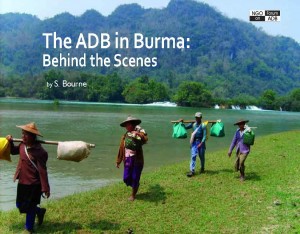The ADB in Burma: Behind the Scenes
By NGO Forum on ADB • April 1, 2011 Burma (Myanmar) became a member of the Asian Development Bank (ADB) in 1973. The ADB has, however, not provided any loans or direct technical assistance to Burma since 1986-1987, purportedly in response to internal political pressure from shareholders after the brutal crackdown by the Burmese military on pro-democracy protesters in 1988. Burma has a substantial debt to the ADB and is currently in arrears. Between 1973 and 1986-87 Burma received loans of US $530 million, and owes the ADB US $325 million.
Burma (Myanmar) became a member of the Asian Development Bank (ADB) in 1973. The ADB has, however, not provided any loans or direct technical assistance to Burma since 1986-1987, purportedly in response to internal political pressure from shareholders after the brutal crackdown by the Burmese military on pro-democracy protesters in 1988. Burma has a substantial debt to the ADB and is currently in arrears. Between 1973 and 1986-87 Burma received loans of US $530 million, and owes the ADB US $325 million.
In 2007, in response to a petition from civil society groups in the region, the ADB states that they are very attentive to the political and security situation in which they operate, and that they have not provided bilateral loans or technical assistance to Burma for almost twenty years, but that they do provide regional technical assistance for GMS meetings. What the ADB position fails to address is the major role that the ADB has played and continues to play in facilitating and mobilizing private sector investment in Burma through the Greater Mekong Subregion (GMS) economic cooperation program, and also facilitating private investment in Burma outside this program. The majority of these projects are in contested ethnic territories and have occurred without informed public participation, and have already had, or will result in environmental and human rights repercussions.
Other activities the ADB has been involved in include International Monetary Fund economic policy reviews in Burma, support for the Myanmar Environmental Performance Assessment, and support for relief and reconstruction after Cyclone Nargis through ASEAN as part of the Tripartite Core Group (ASEAN, UN and Burmese Government). There are some beneficial aspects of these activities but they are limited by the political context.
This paper recommends that until the people of Burma can meaningfully participate in development decisions, preconditions for responsible investment are in place, and adverse impacts can be mitigated, then the ADB should refrain from any form of new engagement with Burma. If they do engage (i.e., fund, facilitate, administer) in Burma, the ADB must follow the International Financial Corporation’s “Sustainability Framework” and adhere to their own safeguard policies, including safeguards on Involuntary Resettlement, Environment and Indigenous People, as well as the ADB’s Accountability Mechanism and Public Communications Policy.
Tags: Asian Development Bank, Greater Mekong Subregion, International Financial Institutions, NGO Forum on ADB, SanctionsThis post is in: Aid, Economy, Environmental and Economic Justice
Related PostsAsian Highway Project Undermines Peace in Karen State
Bridge Loans to the Republic of the Union of Myanmar
Campaigners Criticise “Premature” Burma Debt Cancellation
New Lending Must Address Challenges on Burma’s Road to Development
Myanmar in Transition: Opportunities and Challenges









 All posts
All posts